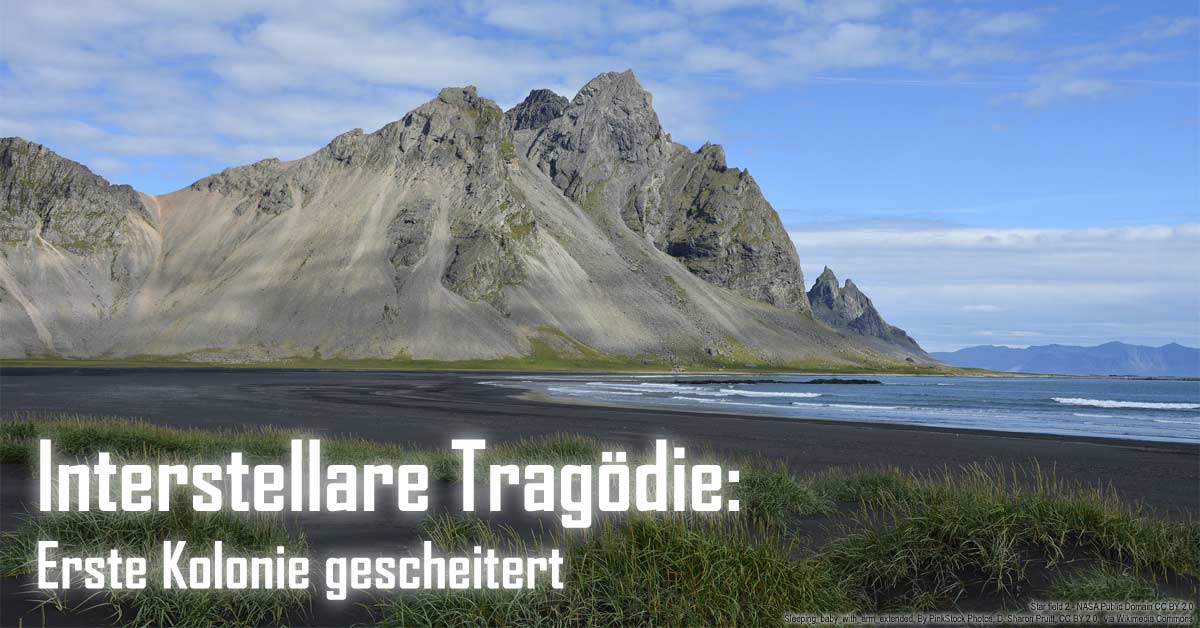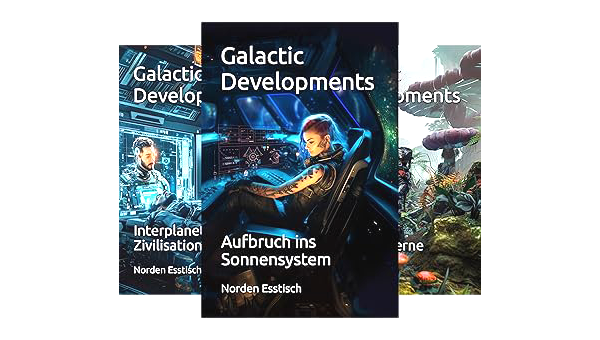
2535 Tragödie von Cobol

Die erste interstellare Kolonie scheitert. An fremden Lebensformen und Feindschaft unter den Menschen.
Die Siedlung auf Cobol ist nicht autark. Aber die Siedler sind sehr gut ausgestattet. Sie haben in allen Bereichen Hightech-Ausrüstung, von Autofabs über Umweltanalyse bis zur Energiegewinnung. Trotzdem dauert es eine Weile, bis sie selbst genügend Nahrungsmittel erzeugen können und bis ihre Fabs aus lokal gewonnenen Rohstoffen alle notwendigen Dinge herstellen. Für diese Zeit ist Unterstützung von außen vorgesehen und vorfinanziert durch die wohlhabende Cobol-Stiftung. Für die ersten 20 Jahre ist jedes Jahr mindestens einen Versorgungsflug geplant.
Aber nach dem Dilan-Zwischenfall 2532 stürzt die interplanetare Wirtschaft des Solsystems in eine schwere Krise. Im Chaos der Fluchtbemühungen werden viele Werte zerstört und viele Wirtschaftsvorgänge unterbrochen. Geschäftspartner sind verschwunden, Lieferbeziehungen sind zerbrochen, Vermögen sind verloren. Der Finanzmarkt liegt am Boden. Auch die finanzielle Situation der Cobol-Stiftung ist prekär.
Deshalb werden die Versorgungsflüge nach Cobol für 18 Monate ausgesetzt. Zwei Flüge entfallen. Anfang 2534 ist es dann endlich wieder möglich, ein Versorgungsschiff auszurüsten. Unglücklicherweise geht das Schiff auf dem Flug verloren. Vermutlich trifft es im interstellaren Raum eine Materieansammlung, einen Irrläufer-Planeten oder eine Häufung dunkler Materie. Auch moderne Überlichtantriebe sind bei hohen Überlichtfaktoren immer noch sehr empfindlich gegenüber größeren Störmassen. Das Schiff kommt nie an.
Mangels interstellarer Kommunikationsmöglichkeiten erfährt man im Solsystem davon nichts. Erst ein zurückkehrendes Schiff könnte die Meldung mitbringen. Das nächste Versorgungsschiff startet 2535. Es kehrt drei Jahre später in das Solsystem zurück und bringt schlimme Nachrichten mit. Die Siedlung auf Cobol ist zerstört. Es gibt Anzeichen für Kämpfe. Man findet etwa 100 Leichen. Es gibt nur wenige Überlebende in den Ruinen der Siedlung. Die Besatzung des Versorgungsschiffs findet Aufzeichnungen, die Auskunft geben über die dramatischen Umstände.
Die Biosphäre von Cobol ist grundsätzlich kompatibel. Aber sie stellt nicht die richtigen Proteine, Vitamine und Kohlenhydrate bereit. Die Siedler müssen alle Lebensmittel selbst herstellen. Das machen sie in modernen Gewächshäusern, wie in der solaren Lebensmittelproduktion auf Kunstsubstraten mit Nährlösungen. Zusätzlich gibt es vollständig künstlich hergestellte Ergänzungsmittel. Man arbeitet daran, erd-kompatible Biomasse aufzubauen, damit man später auch auf traditionelle Weise auf Erde und Humus anbauen kann. Aber neun Jahre nach der Landung ist noch nicht so viel Biomasse entstanden, dass man einfach Lebensmittel im Freien wachsen lassen könnte.
Die Lage der Kolonie auf Cobol wird 2532 problematisch. Ein Pilz von Cobol zersetzt Dichtungen und Bewässerungsschläuche. Er produziert giftige Stoffwechselprodukte, die viele Pflanzen absterben lassen. Die Nahrungsmittelproduktion bricht ein. Reserven reichen nur für drei Monate. Die Siedler kämpfen gegen den Pilz, um die nächste Ernte zu sichern. Der Pilz nistet sich in Wassertanks ein und infiziert von dort aus die wiederhergestellten Leitungen. Auch die nächste Ernte fällt aus. Die Lebensmittel werden rationiert. In der Hydroponik werden Alternativen ausprobiert und die bisher hergestellte erd-kompatible Biomasse wird in Gewächshäusern als Substrat eingesetzt. Aber der Pilz ist hartnäckig und befällt die wertvolle Biomasse. Der Kolonieführung und einigen Wissenschaftlern werden Fehler vorgeworfen.
Die Führung der Kolonie wird jährlich neu gewählt. So ist es in den Statuten der Cobol-Stiftung festgelegt. Die Wahl im dritten Jahr der Krise ist sehr polarisiert. Das Aktionsbündnis TRUTH gewinnt knapp gegen die Wahlliste ScienceRulez. Die neue Führung ordnet den Ausnahmezustand an. Sie baut eine bewaffnete Sicherheitstruppe auf. TRUTH-Kritiker werden suspendiert. Drei Monate später ändert die Führung die Rationierung zugunsten von Personen, die zur Lösung der Krise wichtig sind. Ein Klassensystem wird eingeführt. Führungsmitglieder, Security und einige Ingenieure erhalten volle Rationen. Der Status der übrigen Wissenschaftler wird abgewertet. Die Aufrechterhaltung der Ordnung mit allen Mitteln hat Priorität. Die Hälfte der Leute hungert. Kritiker werden aus der Siedlung ausgeschlossen. Einige werden sogar weit entfernt mit minimaler Ausrüstung abgesetzt. Darunter sind auch Familien mit kleinen Kindern. In der Wildnis kann niemand lang überleben. Verbannung kommt einem Todesurteil gleich.
Es gibt Widerstand gegen die drakonischen Maßnahmen. Beide Seiten fertigen Schusswaffen in Autofabs. Diese Codes sollte es eigentlich nicht auf Cobol geben. Aber irgendwie sind sie doch in das lokale Netz gelangt. Aufständische versuchen die TRUTH-Führung festzunehmen. Es gibt einen erbitterten Kampf zwischen den Aufständischen und der Sicherheitstruppe. Schusswaffen und improvisierte Sprengsätze beschädigen die Siedlung. Auch die Gewächshäuser nehmen Schaden. Die Auseinandersetzungen ziehen sich über mehrere Wochen. Den Aufständischen gelingt es schließlich, TRUTH und ihre paramilitärische Sicherheitstruppe zu verdrängen. Die Aufständischen schneiden ihre Gegner vom Nachschub der Fabs ab. Aber kurz darauf explodieren vorher deponierte Sprengsätze in der Zentrale, den Werkstätten und in Wohnbereichen.
TRUTH Mitglieder hatten bei ihrer Flucht Überlebensausrüstung und die verbliebenen Lebensmittel mitgenommen. Sie richten sich in wissenschaftlichen Außenposten ein und warten auf das nächste Versorgungsschiff. Aber das Leben in der Wildnis ist schwieriger als man in der gut geschützten Siedlung angenommen hatte. Die Menschen in den Außenposten werden immer wieder Opfer einer aggressiven Fauna. Sie werden von großen Tieren angegriffen, wenn sie die Station verlassen. Die Vorräte sind in den Außenposten nicht gut geschützt und leiden durch Insektenbefall. Und das nächste Versorgungsschiff kommt viel später als gedacht.
Bei den Kämpfen sterben 90 Siedler. Die gezielten Explosionen kosten 40 Leben. 50 Menschen wurden schon vor den Kämpfen so weit entfernt abgesetzt, dass sie die Siedlung zu Fuß nicht erreichen können. Die übrigen 120 Erwachsenen und 60 Kinder versuchen unter furchtbaren Umständen zu überleben. 15 Monate später kann das Versorgungsschiff 31 Erwachsene und 25 Kinder retten.
Zwanzig Jahre später wird Cobol wieder besiedelt. Die neue Kolonie ist auf die Herausforderungen besser vorbereitet. Der Pilz, der die erste Siedlung so in Bedrängnis brachte, wird biochemisch neutralisiert. Von Anfang an baut man in großem Stil erd-kompatible Biomasse auf und schafft Enklaven von irdischer Flora und Fauna in denen die Siedler leben. Im Lauf der Zeit verdrängen irdische Arten die ursprüngliche Biosphäre auf allen Ebenen. Viel später existieren nur noch Reste der nativen Ökologie in geschützten Bereichen, während der Planet fast vollständig terraformiert ist. Der erste Fall von Terraformung durch Menschen, auch wenn hier nur die Biosphäre umgewandelt wird, nicht Meteorologie oder gar Geologie.
Nach dem Dilan-Zwischenfall ist die Tragödie von Cobol das zweite ernste Zeichen, dass die interstellare Expansion gefährlich ist. Die Menschen haben ihr eigenes Sonnensystem besiedelt. Schon das war nicht einfach. Die Menschen mussten dabei viele Probleme lösen. Sie mussten technische Schwierigkeiten überwinden und soziale Konflikte bewältigen. Das Solsystem war groß und gefährlich.
Jetzt trifft die Menschheit auf fremdes Leben. Dabei entstehen wieder unerwartete Situationen. Aber die größte Gefahr geht von der Reaktion der Menschen aus. Die Tragödie von Cobol wurde ausgelöst durch eine fremde Lebensform. Aber tödlich waren letztlich die Handlungen der Menschen in der Krise.
Mehr Abenteuer
2135 Sonnenschirm für die Erde
2197 Mond-Revolte
2222 Weltraumpiraten
2412 Pontos Mission
2478 Razzia im Asteroidengürtel
2511 Start der Marco Polo
2535 Tragödie von Cobol
2603 Ein modernes Abenteuer
2646 Anwältin für die Aliens
2648 Abenteuerliche Reise
2677 Superzivilisation
2722 Sein Leben für die Kinder
2725 Auch Maschinen haben ein Gewissen
2749 Gabriele von Pellworn
2843 Gefährliche Bergung
2943 Drachenflugwettbewerb
3010 Wiederbesiedlung Kisors
3131 Roboter und Drachen
Neue Beiträge
2326 Kein interplanetarer Krieg
3050 Königliche Garde
3090 Solo Ehre
2234 Am Ende des Orbits
2248 Gemini-Katastrophe
2366 Orbitale Ökonomie
2222 Weltraumpiraten
2312 Kaio-Artefakt
3361 Erste Menschheit
2333 Metrische Impulsverstärkung
2337 Verschwörung im Orbit
2247 Quantensprung
2158 Space Patrol
2284 Trennung der Erde
2321 Isolation der Erde
2205 Unternehmensnationen
2192 Antiexpansionistischer Terror
2179 Private Asteroidenbasis
2231 Vereinte Planeten
2291 Verbotene Forschung
Die Besten
(20 von 75)
2135 Sonnenschirm für die Erde
2158 Space Patrol
2179 Private Asteroidenbasis
2231 Vereinte Planeten
2265 Öko-Militarismus
2321 Isolation der Erde
2535 Tragödie von Cobol
2540 Mukhagni-Zwischenfall
2587 Alien gegen Alien
2720 Spacedom-Tragödie
2794 Prophet der galaktischen Händler
2806 Weltraum Müll
2915 Belagerungskanone
3010 Wiederbesiedlung Kisors
3042 Galaxien
3116 Shackleton-Aufstand
3225 Flux-Manifest
3296 Drachenlegenden
3353 Tor der Kontroverse
3361 Erste Menschheit
 2533
Die Erde rüstet auf
2533
Die Erde rüstet auf

 2536
Kollisionskurs
2536
Kollisionskurs